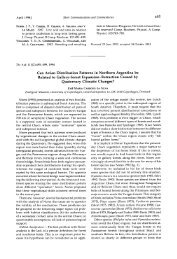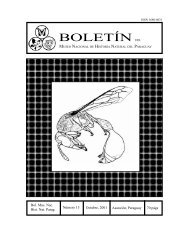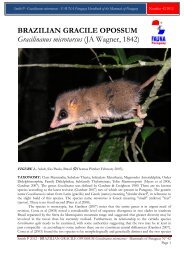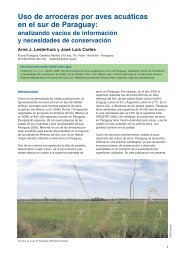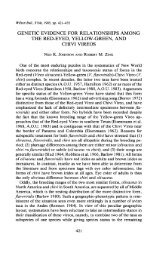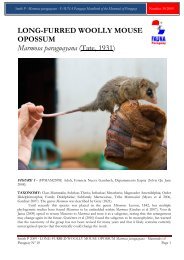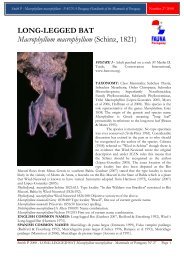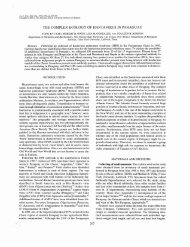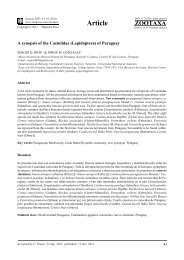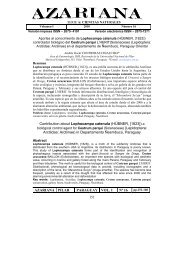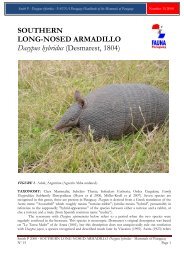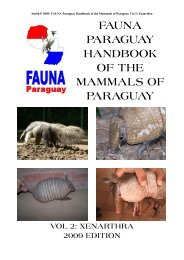Phylogenetic analyses of the bat family ... - FAUNA Paraguay
Phylogenetic analyses of the bat family ... - FAUNA Paraguay
Phylogenetic analyses of the bat family ... - FAUNA Paraguay
Create successful ePaper yourself
Turn your PDF publications into a flip-book with our unique Google optimized e-Paper software.
148 W Bogdanowicz and R. D. Owen<br />
Table 2. Coefficient <strong>of</strong> determination (R*) values adjusted for degrees <strong>of</strong> freedom from linear<br />
regression <strong>of</strong> each study taxon (Rhinolophus spj. on an outgroup (Aselliscus tricupidatus)<br />
Values (when multiplied by 100) indicate percentage <strong>of</strong> original variance for each taxon data<br />
vector explained by outgroup<br />
Taxon<br />
R2 Taxon RZ<br />
acuminatus 0.964 luctus (SE Asia) 0.939<br />
0.955 hctus (India, Ceylon) 0.941<br />
a cyone 0.945 maclaudi 0.952 .<br />
arcuatus 0.950 manotis 0.969<br />
blasii 0.966 madurensis 0.970<br />
bocbaricus 0.953 malayanus 0.971<br />
borneensis 0.972 marshalli 0.955<br />
capensis 0.958 me aphyllus 0.975<br />
celebensis 0.968 me$elyi 0.936<br />
cfivosus 0.955 rnonoce~os 0.971<br />
coelophyllus 0.944 osgoodi 0.970<br />
cognatus 0.971 pearsonii 0.954<br />
comutus 0.968 phili pinensis<br />
0.972<br />
creaghi 0.939 pusi lus 0.971<br />
darlingi 0.958 robinsoni 0.964<br />
deckenii 0.954 rouxii 0.966<br />
denti 0.953 rufus 0.951<br />
eloquens 0.950 sedulus 0.954<br />
euryale 0.941 shameli 0.953<br />
euryotis 0.944 silvestris 0.951<br />
feae 0.967 simplex 0.967<br />
ferrumequinum (Europe) 0.957 simulator 0.959<br />
ferrumequinum (Japan) 0.957 sinicus 0.971<br />
0.949 s<strong>the</strong>no 0.948<br />
fumf~tus graa is<br />
0.953 subbadius 0.959<br />
0.945 subrufus 0.941<br />
f%%:i:dti 0.949 swinnyi 0.957<br />
hipposideros 0.954 thoma+ 0.975<br />
imaizumii 0.973 toxoper 0.973<br />
keyensis 0.964 trifoliatus 0.950<br />
landeri 0.950 virgo 0.970<br />
lepidns 0.971 yunanensis 0.951<br />
sharing a common ancestor with R. cornutus, and R. mfus which seems to be related with<br />
R. shameli, R. coelophyllus, R. arcuatus, R. rreaghi, R, euyotis, and R. subrufus. The group<br />
<strong>of</strong> "typicalm Ethiopian and Palaearctic <strong>bat</strong>s (i. e., without R. cornutus and R. lepidus) is<br />
more homogenous and only R. machrtdi is widely divergent from its congeners. All <strong>the</strong>se<br />
species toge<strong>the</strong>r with Oriental R. luctus, R. trifolidtus, and R. sedulus arose from ancestors<br />
with morphological characters much like <strong>the</strong> present-day R. deckenii.<br />
Consensus tree<br />
An Adams-2 consensus tree combines <strong>the</strong> information <strong>of</strong> <strong>the</strong> size-out and common-part<br />
removed cladograms. As can be expected from a consensus tree based on ra<strong>the</strong>r different<br />
component trees (Figs. 1 and 2), a number <strong>of</strong> unresolved nodes occur on this cladogram<br />
(Fig. 3). In general, <strong>the</strong> consensus tree recognizes <strong>the</strong> poor resolution in several taxa<br />
placed close to <strong>the</strong> root (among o<strong>the</strong>rs in <strong>the</strong> cases <strong>of</strong> R. monoceros and R. megaphyllus;<br />
R. virgo and R, pusillus; R. madurensis, R. lepidus, and R. imaizumii), and suggests that<br />
<strong>the</strong> focal question concerns <strong>the</strong> origin <strong>of</strong> Rhinolophidae. However, in each instance,<br />
Asian, not African, species appear to be most basal in <strong>the</strong> ~h~logeny <strong>of</strong> <strong>the</strong> <strong>family</strong><br />
Rhinolophidae.<br />
P



